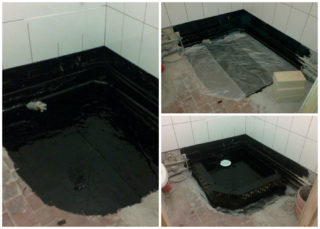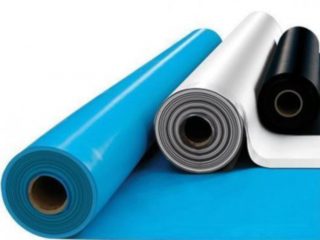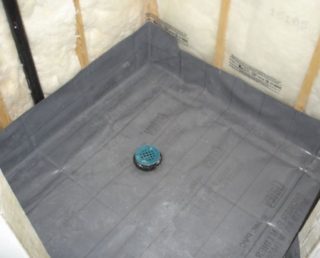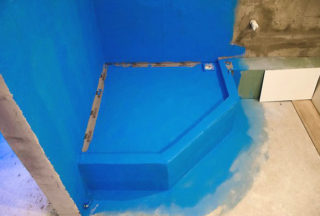A shower room without a tray is a small corner in the bathroom or a separate room in which there is a water outlet and a drain located directly in the floor. When installing this type of shower, special attention must be paid to waterproofing.
What is waterproofing
These include:
- Floor, through the ceiling of which water can freely seep.
- Wall and floor joints.
- Areas of walls where water gets the most.
- Places of entry of communications.
- Areas located around the washbasin and bathtub, if available.
Shower waterproofing is a complex process that consists of several stages and requires mandatory adherence to technology. Everything should be done carefully, without mistakes. Otherwise, the watertightness of the cabin will be of poor quality. It is important to pay attention to the drain structure, which must be built into the floor screed, and fill the rest of the base space with concrete mortar.
Waterproofing materials
- Roll insulator is a proven and reliable water-repellent material that comes in rolls. It is made on the basis of polarized concrete and fiberglass, which have proven themselves in practice. Two insulators are used: self-adhesive and weld-on, which is applied with a certain heating.
- Lubricating sealant. This type of insulation involves the use of bitumen mastic with the addition of polymer or rubber. Both materials have excellent performance characteristics. Noteworthy is the polymer type of mastic, which can penetrate deeply into the surface of the shower floor.
- The cement-resin material also does a good job of protecting cab floors. The cost of such waterproofing is relatively low, and the method of application does not cause difficulties. Popularity is justified by an affordable price. Thanks to polymer additives, it has a high level of adhesion to the surface, is characterized by elasticity and moisture resistance.
- Penetrating insulator is considered to be the most advanced and efficient material. It contains white (quartz) sand, Portland cement and various chemicals. Its active components, reacting with concrete, form insoluble crystalline structures, which serve as a high-quality sealant. The chemical reaction is very slow and lasts for several years. As a result, small cracks that form over time are effectively healed in the base structure.
In order for the sealing to be of the highest quality, several materials are used at once, some of which are glued to the surface, others are spread in layers.For example, ceramic tiles are laid on top of the waterproofing coating. And bitumen insulators, since they are unstable to mechanical damage, are protected with a concrete screed.
The order of work
- As soon as the solution hardens, treat it with bitumen mastic.
- Roll out the insulating material on top, previously cut into pieces of the required size.
- Lay the strips with an overlap of 100 mm and an overlap of about 150 mm on the walls.
- When using overlay waterproofing, solder all joints with a construction hair dryer.
- When laying self-adhesive material, the edges must first be greased with special glue and pressed tightly.
- For better sealing, lay the second layer on top perpendicular to the strips of the previous level.
- Check the quality of the work performed. If air bubbles form under the coating, you should carefully cut them, smear with mastic and treat with a hairdryer.
- A cement mortar screed is made from above for leveling and only after that the tiles are laid out.
- First of all, level the floor with a cement screed.
- After the solution has dried, clean the surface and prime it with a primer.
- Then apply a 4 mm layer of mastic.
- To increase the degree of waterproofing of the cabin, pipes and walls are also treated with material.
- After the mastic is completely dry, a moisture-resistant layer forms.
- A cement screed is made on the floor of the shower room, and then finishing work is carried out.
Polymer-cement compositions are very often used for waterproofing a shower room. They are characterized by high adhesion and excellent elasticity. The process technology is the same as with the coating material.
A penetrating waterproofing agent made of cement and quartz sand with an admixture of active substances can be used for a shower instead of plaster solutions. Only with the difference that the protective property is formed not only on the floor surface, but also inside the layer. A penetrating sealant is applied to the cement base.
The water barrier provides effective insulation, penetrating about 10 cm deep into the material and thus ensuring its stability. Manufacturing process:
- Remove debris and dust from the base. Along the perimeter of the shower room, make a 20 by 25 mm strobe, which should pass along the joints of the base and walls.
- Clean the surface again and moisten well.
- It is necessary to prepare the mixture in accordance with the manufacturer's instructions, otherwise the active ingredients will lose their properties.
- Then put it in the groove (approximate consumption of 1.5 kg per 1 l. M).
- When the material has hardened, moisten the bottom of the walls and floor, and then apply the mixture with a brush.
- Wait until the first layer dries, then apply another one, having previously moistened the surface with water.
- As it dries, periodically moisten the base for 2-3 days.
- After 3 weeks, remove the remains of the cement mixture.
- At the end of all work, you can start finishing. Usually ceramic tiles are laid.
The installation of a shower cabin sometimes causes certain difficulties due to the small space of the room. Therefore, the option of making a shower without a tray will be much more profitable than a standard installation. With diligence and a little creativity, you can get an aesthetic and comfortable shower room.












